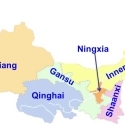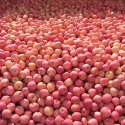09 Oct 2012
Crop Yield and Soil Fertility as Influenced by Nutrient Management in Rainfed Inner Mongolia

The Inner Mongolia Autonomous Region (IMAR) is a relatively arid but still important crop production zone of China. About 70% of crops are rainfed including cereals, potato, rapeseed, and sunflower, which are often grown with under 350 mm of annual rainfall (Table 1). Most farmers in IMAR do not use fertilizer and crop yields are low. Little biomass production within this dry climate also results in inadequate recycling of straw to farm fields. This scenario promotes the gradual decline in soil fertility and crop productivity. A prominent research priority is to develop the steps required to reverse this trend of declining soil fertility through improved nutrient management.
Table 1. The rainfall from 2004-2009 compared with the average from 1961 to 2008 in the experimental site
Year | 2004 | 2005 | 2006 | 2007 | 2008 | 2009 | Average 1961-2008 |
Annual rainfall(mm) | 397.2 | 279.1 | 223.2 | 222.6 | 419.4 | 198.6 | 346.5 |
Rainfall during growing season from May to August(mm) | 297.9 | 210.9 | 172.8 | 83 | 309.2 | 158.5 | 295 |
A six-year fixed experiment was initiated in 2004 at the Arid Crop Station of IMAR, Wuchuan, to study changes in crop response and nutrient balance resulting from selected nutrient management practices. The site evaluated the application of a NPK recommendation (OPT), OPT-N, OPT-P, OPT-K, sheep manure (M), OPT+M, N alone, and a zero input check (CK) at rates outlined in Table 3. Rates within the OPT were recommended based on soil analysis using ASI procedures (Hunter and Portch, 2002) and realistic yield targets for each crop tested. Beginning in 2004, the three-year crop sequence was potato-rapeseed-oat.
Application of N, P, or K fertilizer resulted in improved yields during the timeframe of the field study (Table 2). In the startup year, potato yields increased by 4.3%, 14.4% and 11.6% after application of N, P, and K fertilizer, respectively. After 2004, the recommended NPK treatment produced 10 to 20% more yield than the N, P, or K omission plots, except in 2008 when N and P omission especially affected rapeseed production through 50% and 30% yield reductions, respectively. These larger than average responses are most probably a reflection of higher rainfall at the site, which produced more favorable growing conditions and a higher crop requirement for N and P. Yields under the combined application of NPK and sheep manure was similar or above that achieved with NPK alone. Application of manure alone failed to positively affect potato or oat yields, and reduced rapeseed yields by 20 to 30%. Reliance on N application alone decreased crop yield by 5 to 22%, while the CK reduced crop yield by 15 to 54%.
Table 2. Crop yield response to different nutrient management practices.
Treat. | Potato ‘04 | Rapeseed ‘05 | Oat ‘06 | Potato ‘07 | Rapeseed ‘08 | Oat ‘09 | ||||||
t/ha | % | kg/ha | % | kg/ha | % | t/ha | % | kg/ha | % | kg/ha | % | |
NPK (OPT) | 14.4b | 100.0 | 1,476b | 100.0 | 1,906a | 100.0 | 13.9ab | 100.0 | 1,458a | 100.0 | 1,266ab | 100.0 |
OPT-N | 13.8bc | 95.6 | 1,239cd | 84.0 | 1,630b | 85.5 | 12.4bc | 89.3 | 883c | 49.1 | 1,140bc | 90.0 |
OPT-P | 12.6bc | 87.5 | 1,315c | 89.1 | 1,557bc | 81.7 | 12.4bc | 89.5 | 1,029bc | 70.6 | 1,133bc | 89.5 |
OPT-K | 12.9bc | 89.5 | 1,271cd | 86.1 | 1,573bc | 82.5 | 11.4bc | 82.3 | 1,417a | 97.1 | 1,153bc | 91.1 |
M* | 13.9bc | 96.2 | 1,182de | 80.1 | 1,667b | 87.4 | 13.5bc | 97.5 | 1,038bc | 71.1 | 1,270ab | 100.4 |
OPT+M | 17.1a | 118.2 | 1,648a | 111.7 | 2,005a | 105.2 | 16.3a | 117.7 | 1,483a | 101.7 | 1,335a | 105.5 |
N | 13.2bc | 91.5 | 1,240cd | 84.0 | 1,490bc | 78.1 | 12.0bc | 86.7 | 1,167b | 80.0 | 1,199abc | 94.7 |
CK | 11.9c | 82.2 | 1,105e | 74.9 | 1,354c | 71.0 | 10.8c | 78.0 | 671d | 46.0 | 1,076c | 85.0 |
Table 3. Nutrient input, output and balance during the six successive crops
OPT | OPT-N | OPT-P | OPT-K | M | NPK+M | N | CK | ||
Nutrient input, kg/ha | N | 395 | 0 | 395 | 395 | 411 | 806 | 395 | 0 |
P2O5 | 320 | 320 | 0 | 320 | 185 | 505 | 0 | 0 | |
K2O | 250 | 250 | 250 | 0 | 468 | 718 | 0 | 0 | |
Nutrient removal by crop seed and straw, kg/ha | N | 497 | 353 | 381 | 433 | 348 | 562 | 426 | 298 |
P2O5 | 173 | 129 | 122 | 144 | 125 | 198 | 117 | 102 | |
K2O | 439 | 334 | 317 | 304 | 329 | 517 | 319 | 290 | |
Nutrient balance, kg/ha | N | -102 | -353 | 14 | -38 | 62 | 243 | -31 | -298 |
P2O5 | 147 | 191 | -122 | 176 | 60 | 307 | -117 | -102 | |
K2O | -189 | -84 | -67 | -304 | 139 | 201 | -319 | -290 | |
The nutrient balances calculated after the six successive crops suggest that recommended rates for N or K were not sufficient to balance crop removal, but the P recommendation was excessive and resulted in its accumulation in soil during the years of study (Table 3). Accumulated recoveries for N, P, and K from the six crops were 36%, 16%, and 54%, respectively. Omission plots for N, P, and K generated large deficits of 353 kg N/ha, 122 kg P2O5/ha, and 304 kg K2O/ha during this timeframe. Although manure applications did not affect the crop yields, soil N, P, and especially K were in surplus. Larger accumulations were created under continuous application of the NPK recommendation plus manure.
Soil testing (0 to 20 cm) at the end of the experiment found mineral N (NH4++NO3-) to be lower in all treatments compared with that measured prior to the trial’s initiation (Table 4). The recommended NPK treatment maintained the highest mineral N content followed by NPK plus manure. Soil Olsen-P increased in all treatments with the exception of the N or OPT-P treatments. NPK with manure resulted in the highest Olsen-P values after six crop seasons. Exchangeable soil K in all fertilizer treatments did not change significantly, while the manure-supplying treatments had a measurable positive impact on exchangeable K.
Table 4 Surface soil (0-20cm) nutrient levels before and after six years of experimentation.
Treat. | Mineral N * | Olsen-P, | Exchangeable K, |
mg/L | mg/L | mg/L | |
NPK (OPT) | 33.4 | 28.5 | 73.0 |
OPT-N | 23.2 | 22.8 | 64.7 |
OPT-P | 18.7 | 10.6 | 73.8 |
OPT-K | 18.5 | 25.9 | 70.9 |
M* | 21.1 | 16.5 | 83.5 |
OPT+M | 25.9 | 34.5 | 103.9 |
N | 25.2 | 12.4 | 67.0 |
CK | 18.4 | 16.3 | 63.4 |
Soil before trial | 75.0 | 14.5 | 70.4 |
Under this rainfed rotation system the recommended NPK alone could not sustain the N and K balance, and only its combination with manure led to improved crop yields and soil fertility. It should be highlighted that although the combined use of recommended rates of NPK with manure supported yields and improved soil fertility under these conditions, special caution must be taken against the overuse of all nutrients and its excessive accumulation in soil. Careful monitoring of soil P accumulation is stressed when fertilizer P is used in combination with manure.
Mr. Duan is Professor, Mr. Tuo is Professor, Mr. Zhao is Associate Professor, and Ms. Li is Assistant Professor, with the Plant Nutrition and Analysis Institute, Inner Mongolia Academy of Agricultural and Animal Husbandry Sciences, China; e-mail: yduan@ppi.caas.ac.cn. Dr. Li (e-mail: sli@ipni.net) is Deputy Director, IPNI China Program, in Beijing.
References
Hunter, A. and S. Portch. 2002. Modern Agriculture and Fertilizers, PPI-PPIC China Program, Special Publication No.5, China Agriculture Press, Beijing.







